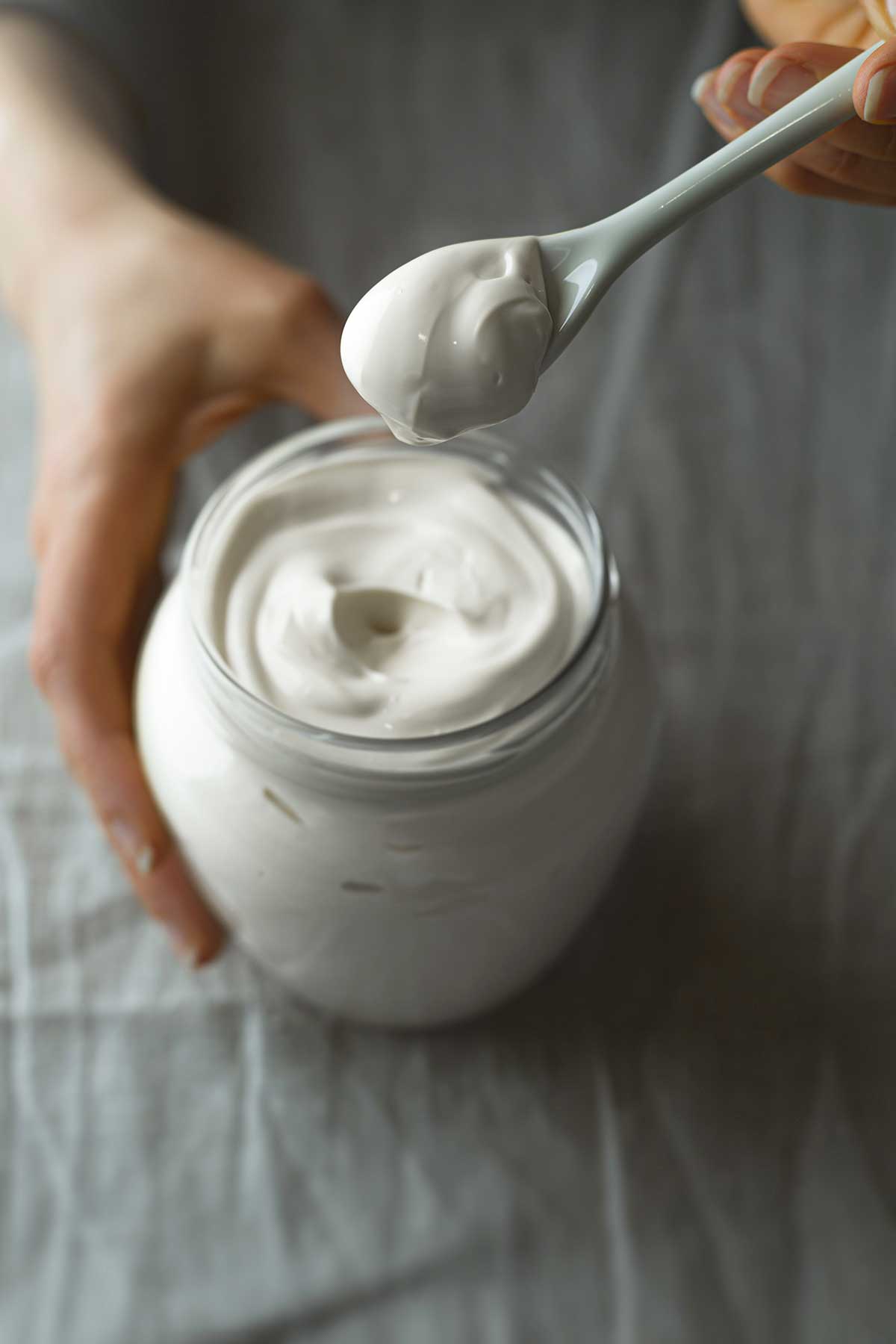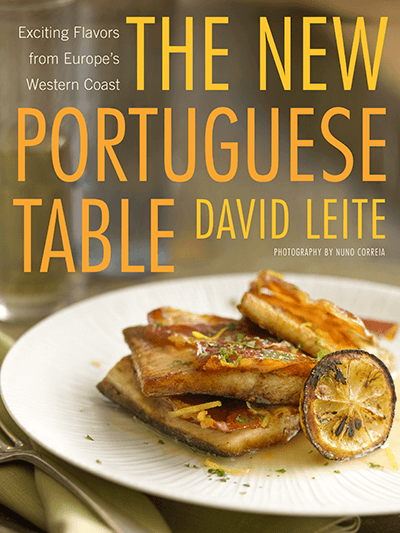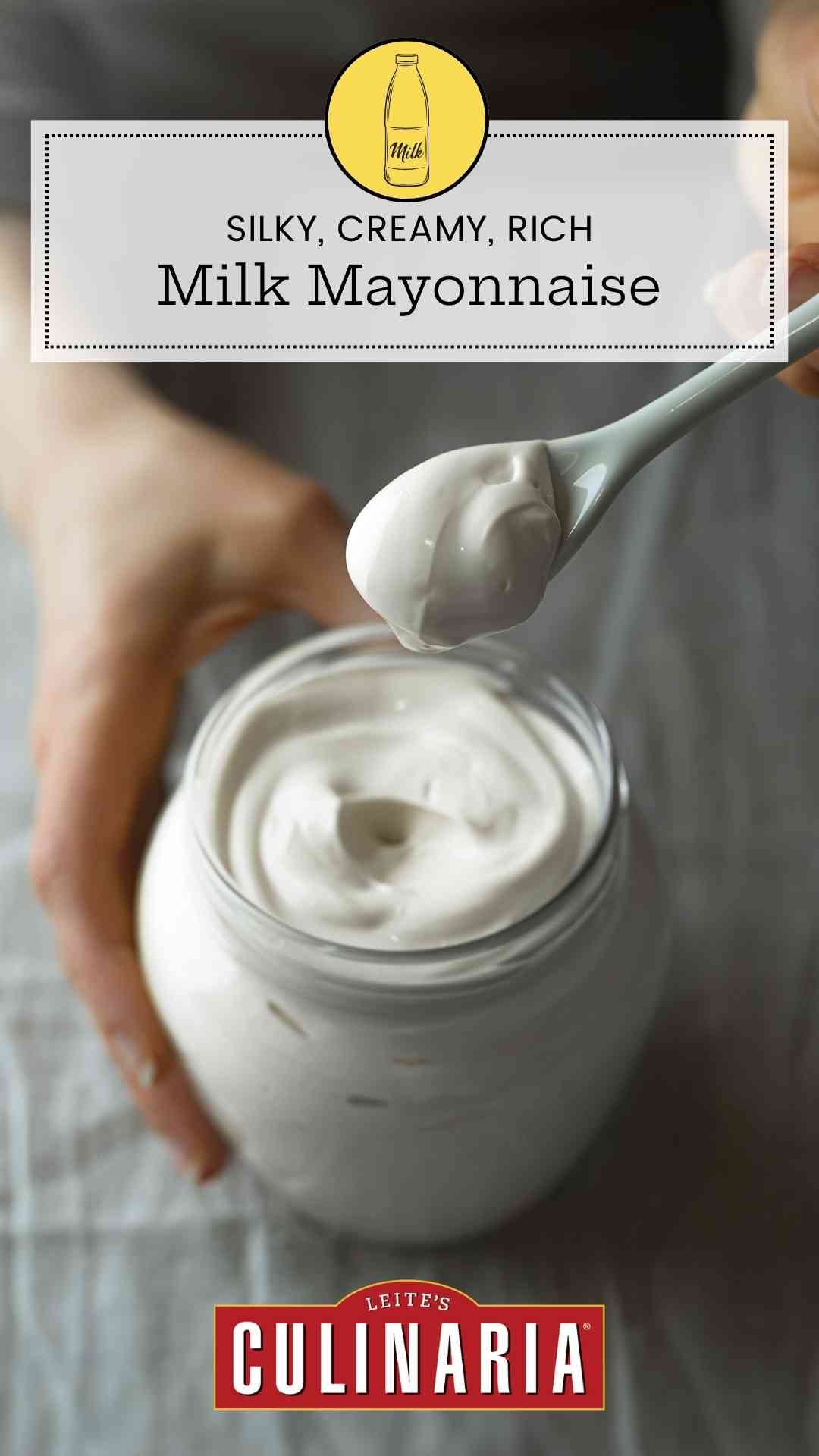
This is one of those recipes that require quotation marks, not out of affectation, but because it’s not a true mayonnaise. It contains no egg yolks or mustard. It’s nothing more than an emulsion of milk and oil. More Brazilian than Portuguese, it’s just now beginning to be used on the Continent. The taste is lighter and cleaner than that of egg-based mayonnaise, allowing other flavors to come through.
☞ Read the Article: The Secret Behind Milk Mayonnaise
Since I was given the recipe, I haven’t stopped finding ways to cook with it. The master recipe is only a canvas for additions. Besides the uses in this book, I’ve smeared the variations on grilled meats and fish, used them as dips and in dressings, spread them on sandwiches, and stirred them into potato salads, much as I do with actual mayonnaise.
Why Isn’t my Mayonnaise Emulsifying?
Like all emulsions, this recipe can be a bit finicky. But adding the oil in a thin stream and stopping when the right consistency is reached is the key. For almost foolproof results, a handheld blender is best, but a small canister blender with a narrow base will do (tall and narrow is best here). Don’t do as some of us did and assume that a stand mixer or food processor will work—it just won’t. If you’re working with a less-than-powerful immersion blender, the consistency of the mayonnaise may turn out thinner than you’d expect. You can help it along by slowly adding 2 more tablespoons of oil to the milk mayonnaise as you continue to blend and it will thicken nicely.

Milk Mayonnaise
Ingredients
- ⅓ cup very cold milk
- ¾ teaspoon fresh lemon juice
- 1 small garlic clove, peeled
- ⅛ teaspoon white pepper
- About ¾ cup vegetable oil, or 1/2 cup (118 ml) vegetable oil plus 1/4 cup (60 ml) olive oil
- Kosher salt
Instructions
- Combine the milk, lemon juice, garlic, and pepper in a 2-cup glass measuring cup. Using a handheld blender (or a blender), buzz on high for 30 seconds until frothy.
- With the motor running on high, slowly pour in the oil a few drops at a time, and gradually increase this to a fine thread, moving the blender up and down, until the mixture thickens lusciously and resembles a soft mayonnaise. You may need more or less oil.
- Season with salt to taste. The mayonnaise will last up to 1 week in the fridge.
Notes
Milk mayonnaise variations
Clockwise from top right: cilantro-ginger, curry, anchovy, sun-dried tomato.
Cilantro and Ginger Milk Mayonnaise | Maionese de Leite com Coentros e Gengibre
Add 1 loosely packed cup of well-dried fresh cilantro leaves and tendril-soft stems and a 1 1/2-inch peeled and grated thumb of ginger to the cup along with the milk, 1 3/4 teaspoons of lemon juice, and the pepper. Omit the garlic. Whir in the oil as directed above. Stir in 1 scallion cut into thin slices on the diagonal.Anchovy Milk Mayonnaise | Maionese de Leite com Anchovas
Add 6 anchovy fillets (generous 1 tablespoon) packed in oil to the cup along with the milk, lemon juice, garlic, and pepper. Whir in the oil as directed above. Omit the salt.Curry Milk Mayonnaise | Maionese de Leite com Caril
Add 2 teaspoons of your favorite curry powder to the cup along with the milk, lemon juice, garlic, and pepper. Whir in the oil as directed above. Before using, let this sit for an hour or so in the fridge to bloom.Tomato Milk Mayonnaise | Maionese de Leite com Tomate
Add 1 1/2 tablespoons of double-concentrate tomato paste to the cup along with the milk, garlic, and pepper. Omit the lemon juice. Whir in the oil as directed above. Stir in 1 tablespoon minced oil-packed sun-dried tomatoes.
Nutrition
Nutrition information is automatically calculated, so should only be used as an approximation.











Made this successfully on my second attempt and Oh, My! This stuff is so lush and amazing. I can’t wait to experiment with all the variations people have suggested here on the page.
On my first attempt, I too wound up with a separated oily mess with milk blobs in it. From the food chemistry side, it appears as though I tried to force too much oil into what had already formed the perfect emulsion. I still had about a third of the oil left, so I thought “This can’t be right. I should add all of it.”
ARRRRGGGHH! The death nell of my mayo! Today, I was much more conservative, careful and less aggressive with the oil. I stopped adding oil immediately when the texture was rigth and it’s perfect.
No wonder you ate it all in one shot!
Athena, I’m so happy to hear it worked well for you. Yes, the amount of oil can vary–I’ve never had as much as 1/3 cup left over, but I think it depends upon how fast you add the oil and how fast the emulsion comes together. The most important thing is to stop when you have that incredible, lovely, light, whipped lusciousness!
Loop back with me and tell me what things you added to your “mayo.” I want to have a list here so that future readers can benefit form your creativity.
I apologize if you have already answered this question, but there are so many great comments that I can’t read them all! I tried this recipe tonight and messed it up. The sad thing is, I think I got a nice mayonnaise but then ruined it. I had used only about half of the oil when it became what I thought might be the goal texture, and then added more just because I was trying to follow the recipe. Big mistake! It became a blender jar full of oil with globs of mayo.
I was wondering, though, if the temperature of the blender also had something to do with it. The recipe calls for very cold milk. I was pouring the oil in extremely slowly because I have never made mayo before; the machine ended up being on for so long that the whole thing was very hot by the time I was through with it. What do you think?
Carrie, the temperature of the blender could be part of it, but I really can’t say as I always suggest this be made with a hand blender or a mini chop. A blender is too large to create a stable emulsion that can hold all that oil. I suggest using either tool and try it again. I think you’ll find it makes a big difference.
Eggs kind of gross me out a lot, especially raw, so the prevalence of mayonnaise-based sauces is a real “grin and bear it” scenario. I’ll be in love with a dish, then I taste the egg and it’s spoiled for me. Which is especially bad this time of year, when fresh tomatoes and Boston lettuce usher in BLT season.
I’ve tried eggless aïolis (too thin), Greek yogurt (wrong flavor, makes the tomato taste off) and butter (just…no). Milk Mayo is the perfect alternative–a little soft and runny but that’s actually better with the juicy tomato and soft, pasty bread that I prefer in my BLTs.
A few notes:
– I used skim milk in a small processor and initially It was a runny mess. Adding more oil and processing a long time fixed the problem. It’s a ratio thing and I bet if you used cream, you could use less oil and get a better balance of milk and oil.
– To the lady who was worried about raw garlic–the sheer amount of oil in this recipe will hedge against the growth of anything nasty. A week should be safe. If you bumped up the acid content it could be even longer. Or just use roasted garlic and a whole lot more of it.
– I was thinking a peanut oil-whole milk mayo would be the perfect condiment for an Elvis-style BLT. Pardon me for blowing your minds, guys.
dasmb,
No minds blown here. I’ve tried and heard of all kinds of variations of milk mayos. My only comment is it shouldn’t be runny. I suspect it’s due to your using skim milk. Whole milk, which the original recipe calls for, makes a thick spreadable condiment. Adding more oil is definitely the solution to the thinness. And as far as the garlic, if you use a small clove, the acid in the recipe has you covered.